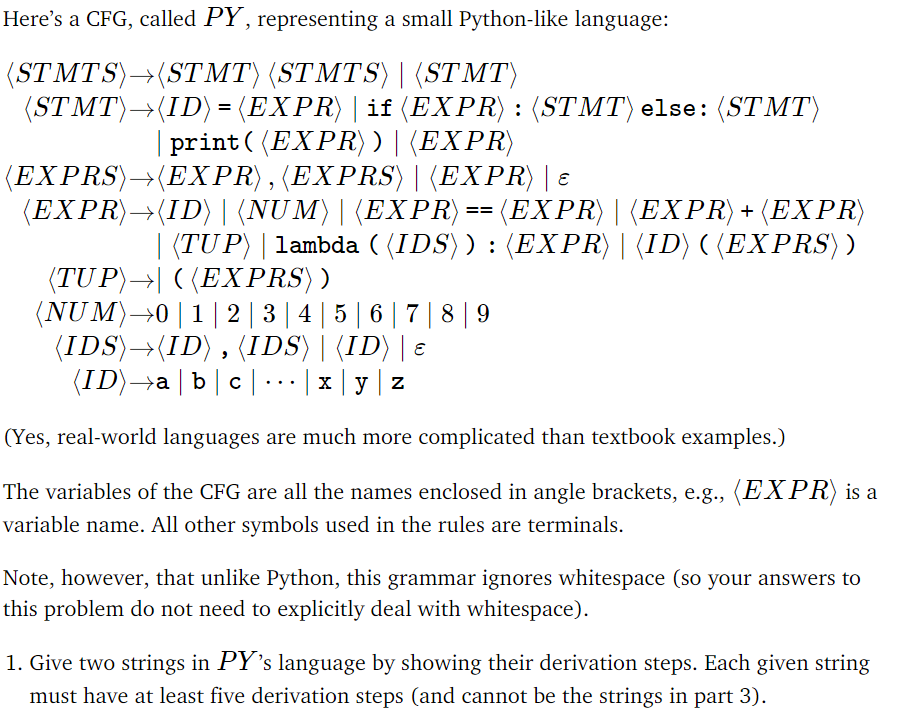Here's a CFG, called PY, representing a small Python-like language: (STMTS)→(STMT) (STMTS)| (STMT) (STMT)→(ID) = (EXPR) | if (EXPR) : (STMT) else: (STMT) | print ((EXPR))|(EXPR) (EXPRS)→(EXPR), (EXPRS) | (EXPR) | ɛ (EXPR)→(ID)|(NUM)|(EXPR) == (EXPR) | (EXPR) + (EXPR) |(TUP) | lambda ( (IDS)) : (EXPR)|(ID) ((EXPRS) ) (TUP)→| ((EXPRS)) (NUM)→0 | 1 | 2 | 3 | 4 | 5 | 6 | 7 | 8 | 9 (IDS)→(ID), (IDS)|(ID) | ɛ (ID)→a | b | c | ... | x | y | z (Yes, real-world languages are much more complicated than textbook examples.) The variables of the CFG are all the names enclosed in angle brackets, e.g., (EXPR) is a variable name. All other symbols used in the rules are terminals. Note, however, that unlike Python, this grammar ignores whitespace (so your answers to this problem do not need to explicitly deal with whitespace). 1. Give two strings in PY's language by showing their derivation steps. Each given string must have at least five derivation steps (and cannot be the strings in part 3).
Here's a CFG, called PY, representing a small Python-like language: (STMTS)→(STMT) (STMTS)| (STMT) (STMT)→(ID) = (EXPR) | if (EXPR) : (STMT) else: (STMT) | print ((EXPR))|(EXPR) (EXPRS)→(EXPR), (EXPRS) | (EXPR) | ɛ (EXPR)→(ID)|(NUM)|(EXPR) == (EXPR) | (EXPR) + (EXPR) |(TUP) | lambda ( (IDS)) : (EXPR)|(ID) ((EXPRS) ) (TUP)→| ((EXPRS)) (NUM)→0 | 1 | 2 | 3 | 4 | 5 | 6 | 7 | 8 | 9 (IDS)→(ID), (IDS)|(ID) | ɛ (ID)→a | b | c | ... | x | y | z (Yes, real-world languages are much more complicated than textbook examples.) The variables of the CFG are all the names enclosed in angle brackets, e.g., (EXPR) is a variable name. All other symbols used in the rules are terminals. Note, however, that unlike Python, this grammar ignores whitespace (so your answers to this problem do not need to explicitly deal with whitespace). 1. Give two strings in PY's language by showing their derivation steps. Each given string must have at least five derivation steps (and cannot be the strings in part 3).
Computer Networking: A Top-Down Approach (7th Edition)
7th Edition
ISBN:9780133594140
Author:James Kurose, Keith Ross
Publisher:James Kurose, Keith Ross
Chapter1: Computer Networks And The Internet
Section: Chapter Questions
Problem R1RQ: What is the difference between a host and an end system? List several different types of end...
Related questions
Question
This Subject is

Transcribed Image Text:Here's a CFG, called PY, representing a small Python-like language:
(STMTS)→(STMT) (STMTS)| (STMT)
(STMT)→(ID) = (EXPR) | if (EXPR): (STMT) else: (STMT)
print((EXPR))| (EXPR)
(EXPRS)→(EXPR),(EXPRS) | (EXPR) | ε
(EXPR)→(ID)|(NUM)|(EXPR):
(EXPR)| (EXPR) + (EXPR)
| (TUP) | lambda ( (IDS)) : (EXPR) | (ID) ((EXPRS) )
==
(TUP)→| ((EXPRS))
(NUM)→0 | 1 | 2 | 3 | 4 | 5 | 6 | 7 | 8 | 9
(IDS)→(ID), (IDS)| (ID) | ɛ
(ID)→a | b | c | · · · | x | y | z
(Yes, real-world languages are much more complicated than textbook examples.)
The variables of the CFG are all the names enclosed in angle brackets, e.g., (EXPR) is a
variable name. All other symbols used in the rules are terminals.
Note, however, that unlike Python, this grammar ignores whitespace (so your answers to
this problem do not need to explicitly deal with whitespace).
1. Give two strings in PY's language by showing their derivation steps. Each given string
must have at least five derivation steps (and cannot be the strings in part 3).
Expert Solution
This question has been solved!
Explore an expertly crafted, step-by-step solution for a thorough understanding of key concepts.
This is a popular solution!
Trending now
This is a popular solution!
Step by step
Solved in 3 steps

Recommended textbooks for you

Computer Networking: A Top-Down Approach (7th Edi…
Computer Engineering
ISBN:
9780133594140
Author:
James Kurose, Keith Ross
Publisher:
PEARSON

Computer Organization and Design MIPS Edition, Fi…
Computer Engineering
ISBN:
9780124077263
Author:
David A. Patterson, John L. Hennessy
Publisher:
Elsevier Science

Network+ Guide to Networks (MindTap Course List)
Computer Engineering
ISBN:
9781337569330
Author:
Jill West, Tamara Dean, Jean Andrews
Publisher:
Cengage Learning

Computer Networking: A Top-Down Approach (7th Edi…
Computer Engineering
ISBN:
9780133594140
Author:
James Kurose, Keith Ross
Publisher:
PEARSON

Computer Organization and Design MIPS Edition, Fi…
Computer Engineering
ISBN:
9780124077263
Author:
David A. Patterson, John L. Hennessy
Publisher:
Elsevier Science

Network+ Guide to Networks (MindTap Course List)
Computer Engineering
ISBN:
9781337569330
Author:
Jill West, Tamara Dean, Jean Andrews
Publisher:
Cengage Learning

Concepts of Database Management
Computer Engineering
ISBN:
9781337093422
Author:
Joy L. Starks, Philip J. Pratt, Mary Z. Last
Publisher:
Cengage Learning

Prelude to Programming
Computer Engineering
ISBN:
9780133750423
Author:
VENIT, Stewart
Publisher:
Pearson Education

Sc Business Data Communications and Networking, T…
Computer Engineering
ISBN:
9781119368830
Author:
FITZGERALD
Publisher:
WILEY